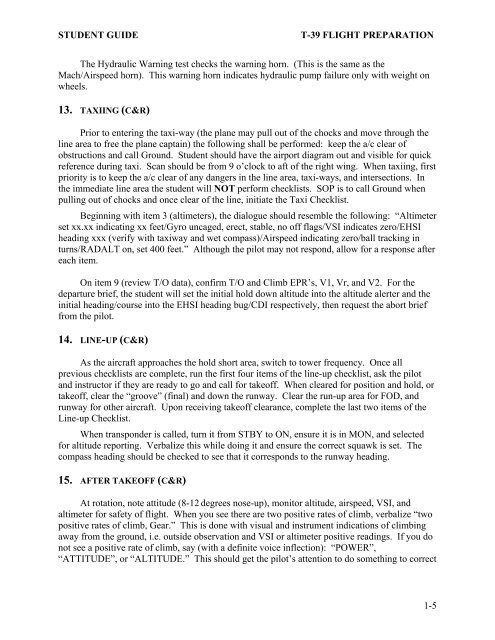t-39 - Chief of Naval Air Training
t-39 - Chief of Naval Air Training
t-39 - Chief of Naval Air Training
You also want an ePaper? Increase the reach of your titles
YUMPU automatically turns print PDFs into web optimized ePapers that Google loves.
STUDENT GUIDE T-<strong>39</strong> FLIGHT PREPARATION<br />
The Hydraulic Warning test checks the warning horn. (This is the same as the<br />
Mach/<strong>Air</strong>speed horn). This warning horn indicates hydraulic pump failure only with weight on<br />
wheels.<br />
13. TAXIING (C&R)<br />
Prior to entering the taxi-way (the plane may pull out <strong>of</strong> the chocks and move through the<br />
line area to free the plane captain) the following shall be performed: keep the a/c clear <strong>of</strong><br />
obstructions and call Ground. Student should have the airport diagram out and visible for quick<br />
reference during taxi. Scan should be from 9 o’clock to aft <strong>of</strong> the right wing. When taxiing, first<br />
priority is to keep the a/c clear <strong>of</strong> any dangers in the line area, taxi-ways, and intersections. In<br />
the immediate line area the student will NOT perform checklists. SOP is to call Ground when<br />
pulling out <strong>of</strong> chocks and once clear <strong>of</strong> the line, initiate the Taxi Checklist.<br />
Beginning with item 3 (altimeters), the dialogue should resemble the following: “Altimeter<br />
set xx.xx indicating xx feet/Gyro uncaged, erect, stable, no <strong>of</strong>f flags/VSI indicates zero/EHSI<br />
heading xxx (verify with taxiway and wet compass)/<strong>Air</strong>speed indicating zero/ball tracking in<br />
turns/RADALT on, set 400 feet.” Although the pilot may not respond, allow for a response after<br />
each item.<br />
On item 9 (review T/O data), confirm T/O and Climb EPR’s, V1, Vr, and V2. For the<br />
departure brief, the student will set the initial hold down altitude into the altitude alerter and the<br />
initial heading/course into the EHSI heading bug/CDI respectively, then request the abort brief<br />
from the pilot.<br />
14. LINE-UP (C&R)<br />
As the aircraft approaches the hold short area, switch to tower frequency. Once all<br />
previous checklists are complete, run the first four items <strong>of</strong> the line-up checklist, ask the pilot<br />
and instructor if they are ready to go and call for take<strong>of</strong>f. When cleared for position and hold, or<br />
take<strong>of</strong>f, clear the “groove” (final) and down the runway. Clear the run-up area for FOD, and<br />
runway for other aircraft. Upon receiving take<strong>of</strong>f clearance, complete the last two items <strong>of</strong> the<br />
Line-up Checklist.<br />
When transponder is called, turn it from STBY to ON, ensure it is in MON, and selected<br />
for altitude reporting. Verbalize this while doing it and ensure the correct squawk is set. The<br />
compass heading should be checked to see that it corresponds to the runway heading.<br />
15. AFTER TAKEOFF (C&R)<br />
At rotation, note attitude (8-12 degrees nose-up), monitor altitude, airspeed, VSI, and<br />
altimeter for safety <strong>of</strong> flight. When you see there are two positive rates <strong>of</strong> climb, verbalize “two<br />
positive rates <strong>of</strong> climb, Gear.” This is done with visual and instrument indications <strong>of</strong> climbing<br />
away from the ground, i.e. outside observation and VSI or altimeter positive readings. If you do<br />
not see a positive rate <strong>of</strong> climb, say (with a definite voice inflection): “POWER”,<br />
“ATTITUDE”, or “ALTITUDE.” This should get the pilot’s attention to do something to correct<br />
1-5
















